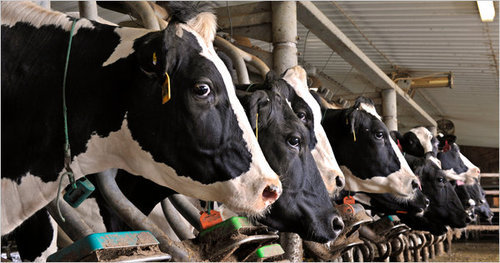Report: Agriculture in N.Y. is booming industry
Agriculture contributed $37 billion to New York’s economy in 2012, up 22% from 2007, a report released Tuesday found.
The state has put a renewed focus on its farms as New York has become the nation’s leader in yogurt production and as its wines received greater praise and attention.
Indeed, New York ranks in the top 10 in the nation for milk and other dairy production, as well as wine, apples and maple syrup, the report from Comptroller Thomas DiNapoli found.

“New York’s economy is still fueled by agricultural activity and the production of food,” DiNapoli said in a statement. “Farms in New York are 98% family-owned, yet compete on a national level, diversifying our economy and keeping our local communities strong.”
Milk is the state’s largest commodity, with $2.4 billion in sales, followed by grains, peas and beans at $856 million, according to the U.S. Department of Agriculture’s 2012 census, the most recent available, DiNapoli’s report notes.
As a result, New York leads the nation in yogurt production because of the booming Greek yogurt sector. The state also ranks first in cottage cheese and sour cream production, the report said.
Because of its vineyards in the Finger Lakes, Hudson Valley and Long Island, the state ranked second in wine production in 2013. It also was second in maple syrup production, behind only Vermont, DiNapoli said.
The Finger Lakes region had 113 wineries, the most of any region in New York and was recently named the Wine Enthusiast’s top wine destination of 2015, DiNapoli’s report notes. In addition, the region ranked first for milk, grains and dry beans.
New York’s apple industry has been ranked the second highest every year since 1996 and the third highest in grape production every year since 1987, a report from Gov. Andrew Cuomo last month said.
Cuomo has boosted the state’s farming industry by loosening regulations and focusing on yogurt production, as well as new cideries and breweries.

“Comptroller Tom DiNapoli’s report calls attention to the significant economic impact agriculture has in New York state,” said Dean Norton, president of the New York Farm Bureau, in a statement. “This in-depth look highlights the dedication of farmers, the diversity of products and the unmistakable conclusion that agriculture is a cornerstone of our rural economy both upstate and on Long Island.”
In 2012, New York had about 56,000 farm operators with an additional 61,000 people hired as farm laborers. As of 2012, New York was home to more than 35,500 farms, including 842 that are certified as organic, the report said.
The average size of farms in New York is relatively small at 202 acres, up from 197 acres in 2007. The national average was 434 acres.
In the Hudson Valley, the region had 52 wineries and ranked first in the state for the number of horses, ponies and donkeys.
There was a small decline in farms between 2005 and 2012, and there were warning signs ahead: The average farmer’s age is 55 years old and more than half of farmers had sales less than $10,000, DiNapoli said.
“It makes economic sense for the state to retain and promote our farms to feed our residents and preserve our land,” DiNapoli said.
